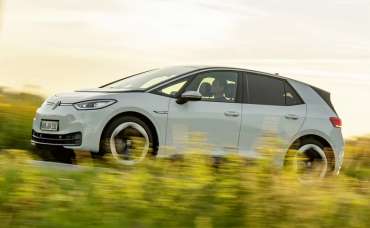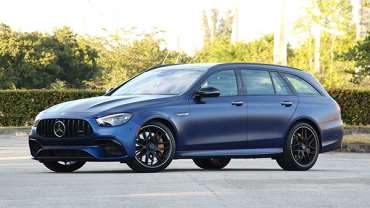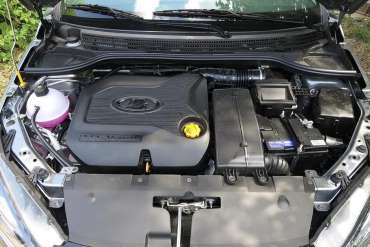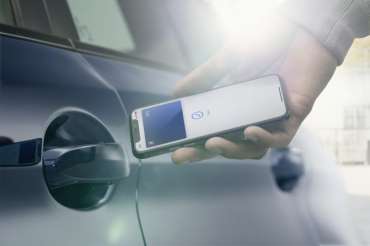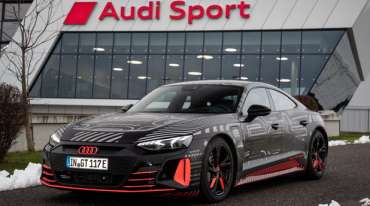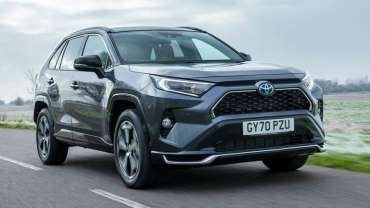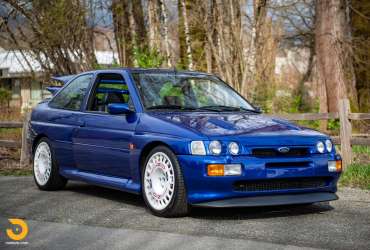
Worldcarblog.com
Are electric vehicles cheaper to maintain than diesel and gasoline?
Audi estimates that the cost of maintaining an electric car is more than 40 percent lower than a car with conventional fuel
An electric vehicle has far fewer moving parts than a combustion engine. In addition, the architecture is much simpler and the concept less susceptible to wear. There is no replacement of the catalytic converter, oil or air filter, or spark plugs, timing belts or clutches to replace or change the oil. What electric car owners are also interested in, in addition to the purchase price and consumption, are the maintenance costs. But how much less is that compared to an internal combustion engine? We went out to market and found some examples of brands to compare. Surprisingly, the numbers were quite different.
Ford points out that with its fully electric Mustang Mach-E, it saves more than 60 percent over five years compared to traditional gasoline vehicles. Audi estimates that the cost of maintaining an electric car is more than 40 percent lower than a car with conventional fuel.
Volkswagen points to a 35 percent reduction in maintenance and repair costs, relying on data from Germany's Für Automobilwirtschaft (IFA).
However, a big problem is the high purchase price of electric cars, and the fact that electricity is often quite expensive at charging stations in Europe. Thus, the financial advantage of electric cars is currently questionable.
2021 Mercedes-AMG E 63 S Wagon Review
With all the doom and gloom regarding the current state of the station wagon in the US, there is some good news. American buyers at least have three fast wagons at their disposal in 2021 (assuming they can afford any of them): the Audi RS6 Avant, the Porsche Panamera Turbo Sport Turismo, and the vehicle you see pictured here – the Mercedes-AMG E63 S Wagon. And each one of these wonderful long-roofs is very good in its own way.
The E63 S in particular blends German luxury and technology with AMG grunt, creating a sizable package that’s impossible to ignore. And with modest updates for the 2021 model year that extend throughout the E-Class range, there are few arguments against the 603-horsepower AMG in the search for your next fast family hauler.
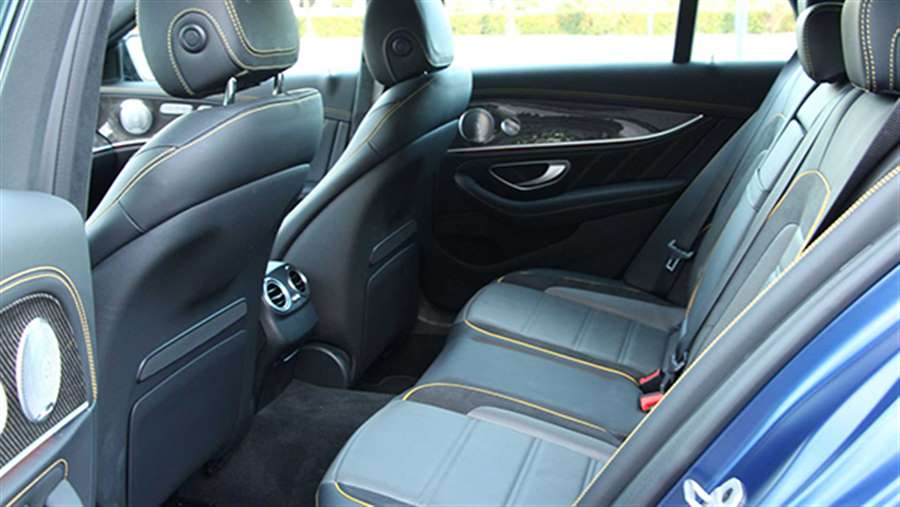
A vehicle’s ratings are relative only to its own segment and not the new-vehicle market as a whole. For more on how Motor1.com rates cars, click here.
Design
You’re probably in one of two camps: Either you love the look of the E63 as a devotee of the niche but ferocious group of wagon fanatics or you hate it, associating the term “station wagon” with something your elderly grandfather might drive. We’re not total wagon zealots like some, but we certainly lean toward the former – particularly when it comes to this exact car. Our $140,000 E63 wears a ridiculously cool Designo matte blue paint job, matte black 20-inch wheels, carbon fiber accents, a blacked-out grille, and carbon-ceramic stoppers with bold copper calipers. It’s a gorgeously styled station wagon.
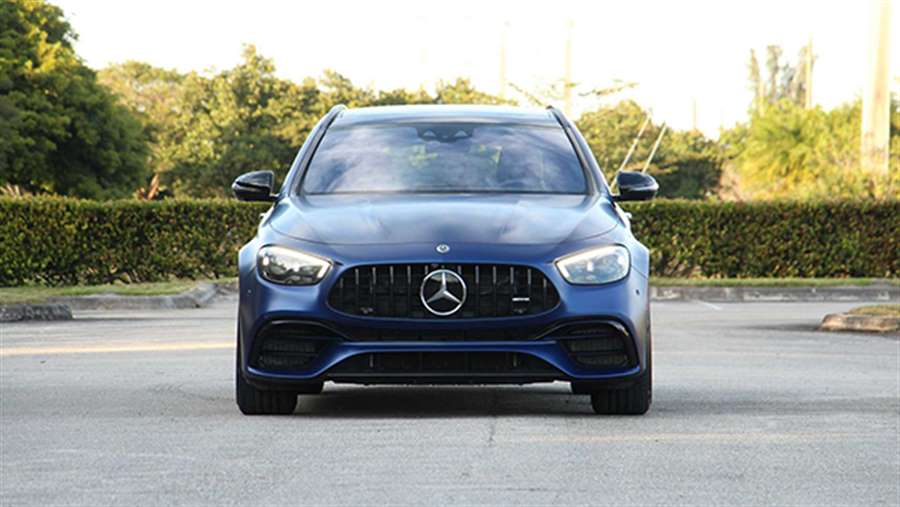
Those AMG-specific appointments join a lightly revised fascia that spans the entire E-Class range for the 2021 model year. The new front-end consists of updated headlights, a sharper grille (inspired in-part by the GT coupe), and slightly larger vent openings. The new features are minor, but they do help improve the overall look compared to last year.
The interior of the E63 wagon is, expectedly, very familiar and very stunning. It looks and feels like almost every other Mercedes in the current lineup, which is a good thing. High-quality Nappa leather and Alcantara (standard on this model) drape the seats and steering wheel, while sublime yellow accent stitching coats the dash and door panels and a beautiful black Dinamica headliner ($1,600) covers the roof.
Comfort
Even with low-profile tires and a raucous V8, the E63 S is a sublime cruiser when it needs to be. In Comfort mode, the fast wagon putts along with nary a care. The highly adaptive Mercedes suspension is so well-damped in this setting that it easily shrugs off bumps and imperfections, creating a cloud-like ride.
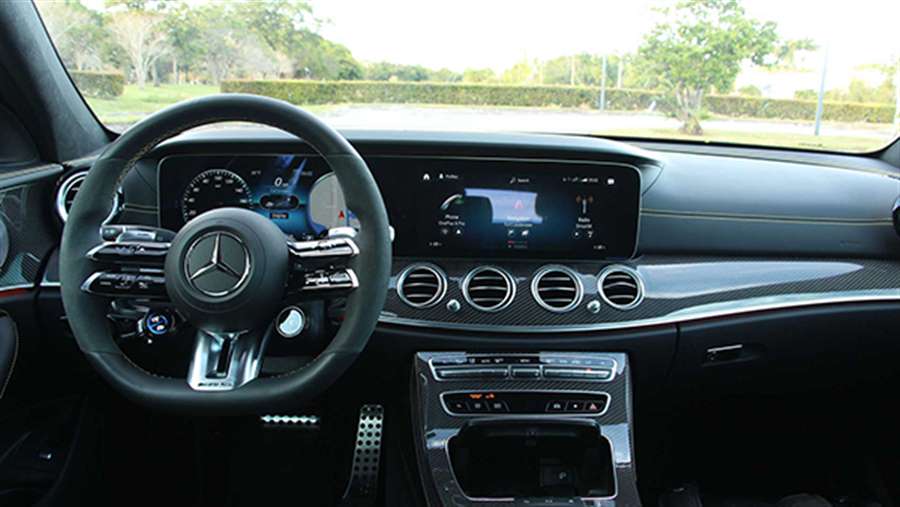
The steering is relatively light in this mode, too, which makes the large machine pretty easy to maneuver. And above all, the E63 is whisper quiet on the inside. As with most modern Mercedes products, insulation and sound deadening on the E63 are unsurpassed – especially with the optional Acoustic Comfort package. The $1,100 option adds improved heat and noise insulation and infrared-reflecting laminated glass.
Passenger and cargo space is another positive point for the E63 wagon – there’s just so much room. The front cabin affords the driver 37.5 inches of headroom and 41.7 inches of legroom, which is on par with the RS6 Avant’s 38.3 inches and 41.3 inches of front head and legroom. Passengers in the rear of the E63 wagon also get a solid 38.2 inches of headroom thanks to the raised roof, which is again close to the RS6 Avant (39.5 inches). Bottom line: even taller humans will be comfortable in the second row over long distances.
But if you’re buying a wagon over an E63 sedan, cargo space is what you’re most likely after. And the E63 has plenty of it; there are 35.0 cubic feet behind the second row and 64.0 cubes with that second row folded. The RS6 only has 30.0 cubic feet behind the second row, and with the rear seats folded, it offers 59.3 cubic feet.
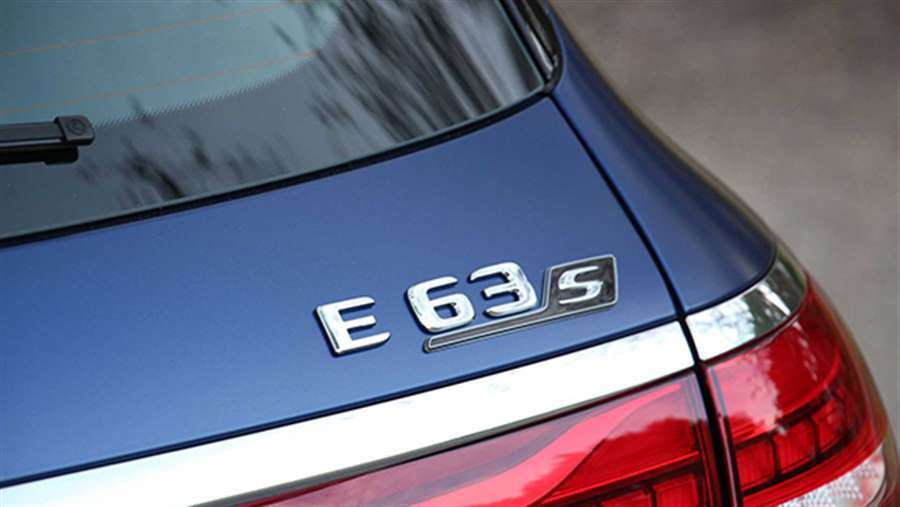
Technology & Connectivity
We’ve always had very positive things to say about the Mercedes-Benz MBUX infotainment system. It offers great features like “Hey, Mercedes” voice commands and augmented reality navigation, and is generally very easy to use. But Benz updated some of the hardware here – the steering wheel controls in particular – and it’s somehow slightly worse.
Mercedes removed the simple volume dial, haptic feedback buttons, and cruise control selector on the steering wheel and implemented a more convoluted button-less setup that consists of two piano black inserts with fully touch-capacitive controls. As we noted in our first drive of the E53 sedan, the setup simply doesn’t work as well as last year’s version did. The cruise control layout on the left side of the steering wheel is especially confusing and difficult to use; it’s unclear exactly which selection does what. And things like the swipe directional responses aren’t well-received.
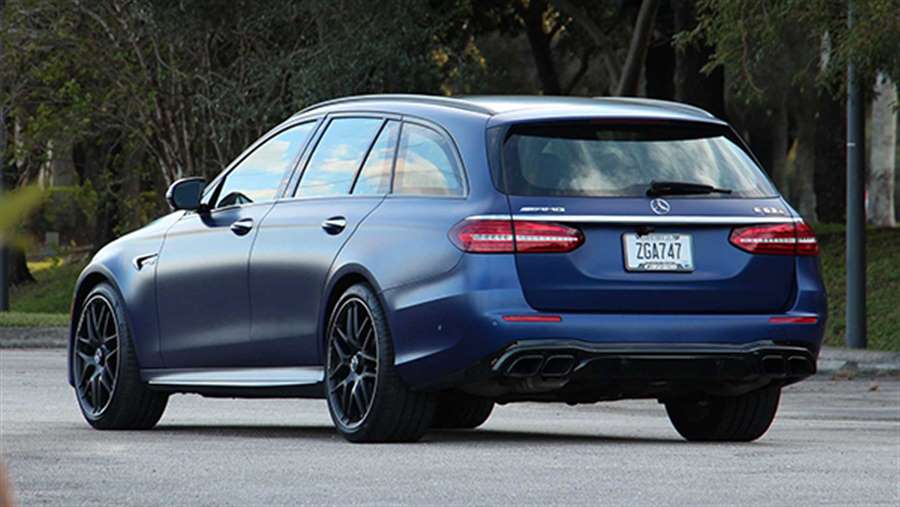
That said, MBUX is still one of the most comprehensive infotainment systems out there. The 12.3-inch touchscreen offers clean, crisp graphics, a relatively easy to use layout, and tons of features, plus a 12.3-inch digital instrument cluster with many of those same options. The addition of a drive mode selector dial on the steering wheel and a corresponding roundel on the opposite side for exhaust note, suspension, stability control, and transmission settings is a nice addition for 2021, as well.
Performance & Headling
“Blistering” feels like the most appropriate word to describe the E63 S Wagon in a straight line; this thing will shove you and all four friends into their seatbacks without hesitation. In Sport Plus and Race modes specifically, the ferocious twin-turbocharged 4.0-liter V8 rips to 60 miles per hour in 3.4 seconds courtesy of 603 horsepower and 627 pound-feet – all of that torque available between 2500 and 4500 rpm. And at high speeds, the E63 S shows no signs of slowing. Power seemingly never plateaus or diminishes, even well near redline.
All that power routes to each wheel via the 4Matic+ all-wheel-drive system, which affords the E63 plenty of grip. An AMG-tuned nine-speed automatic, meanwhile, transmission manages it all – and exceptionally well. The transmission shifts with a crisp decisiveness in Sport and Race modes, but it can be a bit lethargic in some of the other lesser settings.
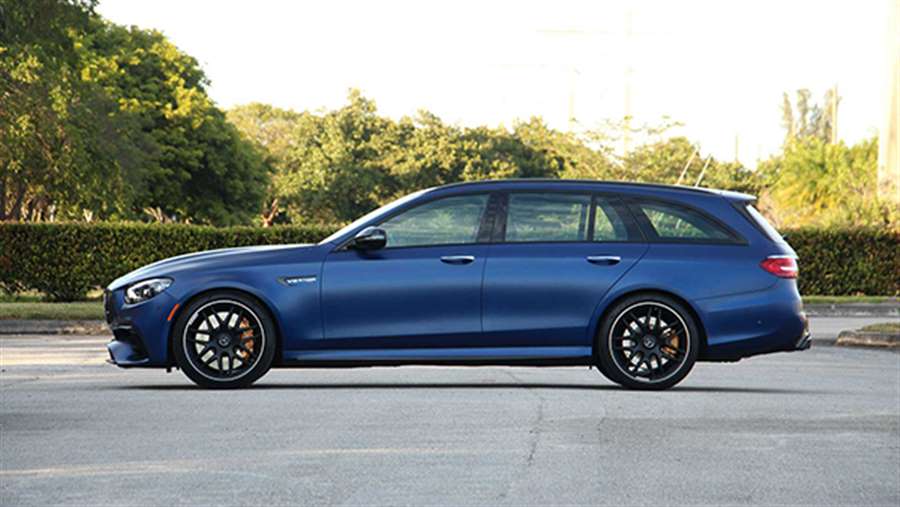
Don’t be fooled by the E63’s length and weight (197.1 inches and 4,725 pounds, respectively), though. This wagon is a sublime companion for twisty roads. The big-bodied AMG keeps perfectly flat even in the tightest turns as the adaptive dampers – in their stiffest setting – all but eliminate body roll. The steering is tight and reactive, and when joined by the Michelin Pilot Sport 4S summer tires (265/35R-20 front, 295/30R-20 rear), there’s ample feedback from the road to your fingertips. And there’s even a drift mode, which disconnects the front axle and sends power solely to the rear (but it’s not for use on public roads).
Safety
The E63 wagon comes with things like automatic emergency braking, car-to-car communication, active parking assist, and a 360-degree camera right out of the box. But with the Driver Assistance package (a $1,950 option), the E63 also gets evasive steering assist, active lane-keep assist with lane-centering, lane-change assist, adaptive cruise control with stop-and-go, and more.
Mercedes-Benz, in our experience, has one of the best active safety systems around, eclipsing BMW and Nissan and rivaling more advanced options from Tesla or Cadillac. And that’s still true here in the E63 Wagon; a simple click of the steering wheel-mounted cruise control function and the Mercedes system does most of the work for you.
On the highway, constant steering adjustments keep the E63 perfectly centered in the lane. Adaptive cruise brakes smoothly all the way down to zero and even modifies the speed setting automatically depending on local limits (if you so choose) or, using GPS data, for upcoming highway bends. And the lane-change assist is our favorite feature, which moves the car automatically into the next lane at the flick of the indicator stalk.
Fuel Economy
The Mercedes-AMG E63 S Wagon’s twin-turbo V8 achieves a modest 16 miles per gallon city, 23 highway, and 18 combined, just two points below our target combined fuel economy for the class. Considering there are really only two other cars in this specific segment, the E63 S sits right in the middle of the pack. The Audi RS6 Avant achieves just 17 mpg combined, while the Panamera Turbo Sport Turismo gets a slightly better 18 mpg combined. Naturally, premium fuel is a must.
Pricing
The Mercedes-AMG E63 S Wagon is not cheap – but neither is anything else in this class. The AMG model starts at $112,450 before options, making it a good bit more expensive than the Audi RS6 Avant ($109,000), slightly pricier than its sedan sibling ($107,500) – if you fancy the four-door – but still more affordable than the Panamera Sport Turismo ($157,000). Our car costs $139,711 post options, and there are plenty of them.
Just on the visual side, the E63’s Design Brilliant Blue Magno is a $3,950 extra, the carbon fiber accents are $2,850, the matte black wheels are $2,000, the black Dinamica headliner is $1,600, and the darkened grille is $450. And as far as performance goes, the carbon-ceramic brakes are the most expensive option of the lot, asking a whopping $8,950 (and you get them in a few different colors). The Driver Assistance package is another $1,950, and Acoustic Comfort is $1,100.
Source: mercedes-world.com
Avtovaz discovered a serious defect on the atmospheric 1.6l 16v engine
AvtoVAZ came to the discovery of a serious problem on engines with sixteen valves, working volume 1.6 liters, with commercial designations VAZ-21126 and VAZ-21129. According to what can be read on the "Lada-online" portal, the above-mentioned drive units can express a problem with the cylinder head, or popularly speaking, with the engine head. The car giant ordered the distributors of Lada vehicles to inspect the stocks in the warehouses and remove a certain number of cylinder heads and related components from circulation.
A possible problem with the 16-valve Lada engine with a volume of 1.6 liters was reported and disclosed on the mentioned Lada-online portal, by the responsible persons in one of the spare parts stores. The announcement caused all Avtovaz business partners who hold the engine heads in their possession to be invited and return them to the factory address. Thanks to the poor quality engine heads, vehicles that have it can additionally notice a problem with the camshaft, ie the possibility that it can be heard too loudly.
Engines marked VAZ-21126 and VAZ-21129 are currently under the hoods of Lada Granta, Vesta, XRay and Largus. AvtoVAZ has not yet officially come forward, ie it has not disclosed information about the problem, nor has it initiated the action of withdrawing the vehicle, so it is not possible to estimate the number of affected vehicles, ie specimens with defective engine heads.
Following social networks, it can be concluded that faulty cylinder heads were installed in vehicles that derailed at the very end of 2020.
Not for consolation, on the contrary, but problems with the cylinder head did not bypass even the most prestigious engine in the manufacturer's offer, so in November last year, the designer was forced to change the design of this component due to numerous complaints from owners due to increased engine oil consumption. We did not say that the VAZ-21179 unit, which offers 1.8 liters of volume, is at the top of Lada's engine range.
Source: Autorepublika
Smartphones will soon replace car keys
Although it is not news that the car is unlocked with a mobile phone, although only from close range, there is now a new technology on Wednesday that will allow us to do it remotely, as we normally do with keys.
Among the many things that smartphones have "suffocated" or at least pushed into the background, such as MP3 players, digital cameras, GPS devices and bank cards, we will soon add another to this list that we use every day - car keys .
Although mobile phone unlock technology is already in use, it is NFC-based, which means you have to lean the phone against the vehicle, but thanks to another technology (UWB), cars will unlock phones remotely, as they do now we work with keys.
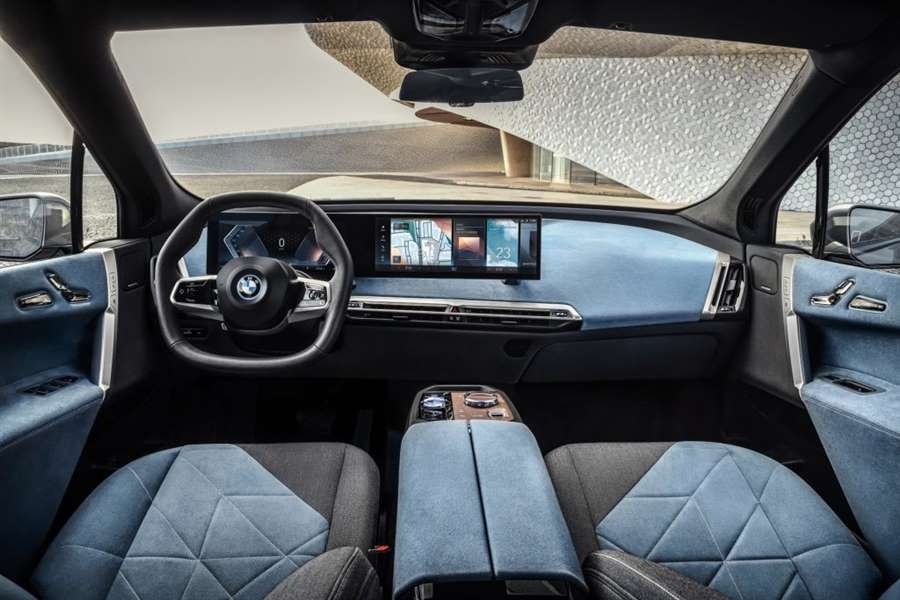
BMW iX, Photo: Promo
New models of Apple phones come with this technology, so BMW recently announced that UWB will use it on its new iX series electric vehicles.
The principle on which UWB works is best described on Wired, calling it "bluetooth on steroids", while Apple calls it internal GPS.
It is a short-range radio technology that will enable not only wireless communication with other devices, for example. unlocking the car door remotely, but also finding other devices nearby, similar to how devices like Tile's popular locators do.
Apple is not the only mobile company whose phones have UWB support - Samsung recently announced the Galaxy S21 series, which also implements this technology, and even before that, Xiaomi in the Mi10 series.
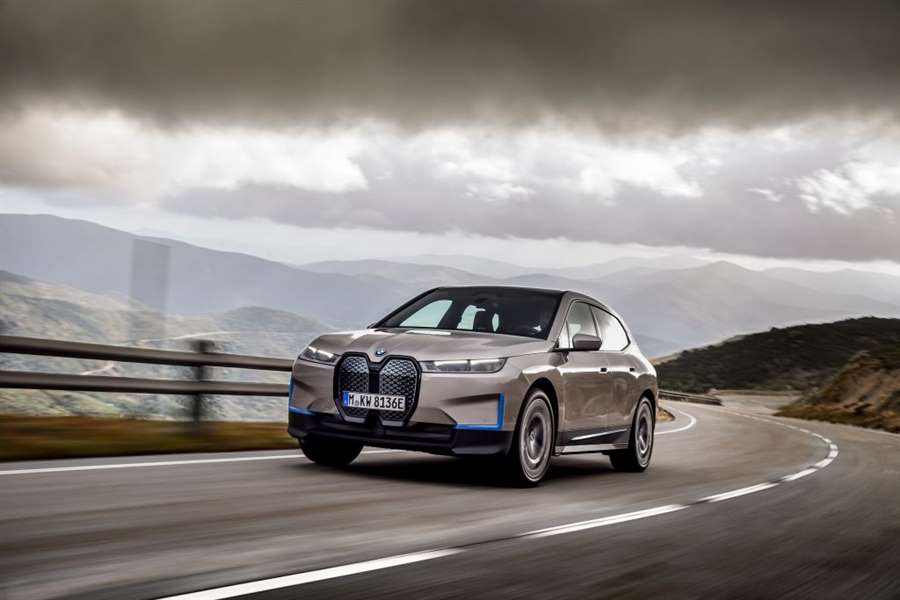
BMW iX, Photo: Promo
It seems like this is just the beginning because, according to information from the mobile industry, more and more companies are planning to introduce a phone with UWB support. So this year we can expect new Xiaomi phones with UWB support, but such devices are also being prepared by Oppo, Vivo and other companies, which means that many phones of the future will be able to replace car keys.
Of course, in addition to mobile manufacturers, UWB should also be accepted by car manufacturers. BMW has already confirmed this, and Samsung has announced that it is also cooperating with Audi, Ford and Genesis, so it is not difficult to assume that in the (near or distant) future, support for digital keys could become an industry standard.
Audi will phase out internal combustion engines by 2040, what about BMW?
Another Bavarian brand is currently working on several purely electric models that will debut in the next 10 years. However, the ambitions of the producers from Ingolstadt are much bigger. According to the head of the company, Marcus Disman, Audi plans to become purely "electric" in the next 20 years.
In fact, it is a time frame that is conceived as necessary to complete the transition, write Vrele Gume. According to Disman, Audi is currently setting a deadline for the phasing out of current models with internal combustion engines. The cars in question will either become purely electric or will be euthanized.
By the end of 2021, the Ingolstadt brand will have six purely electric models on offer, along with 12 plug-in hybrids. However, that is just the beginning. Audi wants to have twenty electric cars on sale by 2025, and if it succeeds in achieving that, it could become a manufacturer like Tesla sooner rather than later.
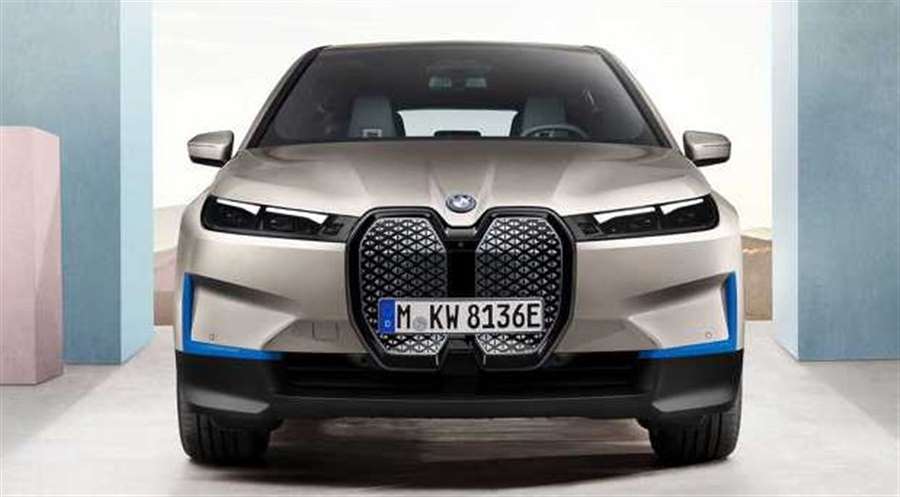
However, it should not be forgotten that Ingolstadt announced that they will continue to develop internal combustion engines, in an attempt to make them as efficient as possible. So, regardless of the fact that Audi will start phasing out the SUS engine, petrol engines will still have their place in the portfolio. "Plug-in" hybrids are likely to serve as long-distance models, giving customers who frequently travel hundreds of miles "from the train" the opportunity to own usable vehicles. Those who are not outspoken "long-distance runners" will be able to rely on electric cars. At the moment, there are only four different electric models of Audi on offer, with two being actually model variants. The Audi e-tron, e-tron Sportback, e-tron S and e-tron Sportback S are currently the only ones of their kind in the Ingolstadt range. However, by the end of the year, the Audi e-tron GT and Audi Q4 e-tron will enter the scene, with probably a couple of new "plug-in" hybrids.
Given all the above, the goal of the "four rings" brand to become purely electric in the next 20 years is not so unattainable. Will other premium manufacturers follow this matrix?
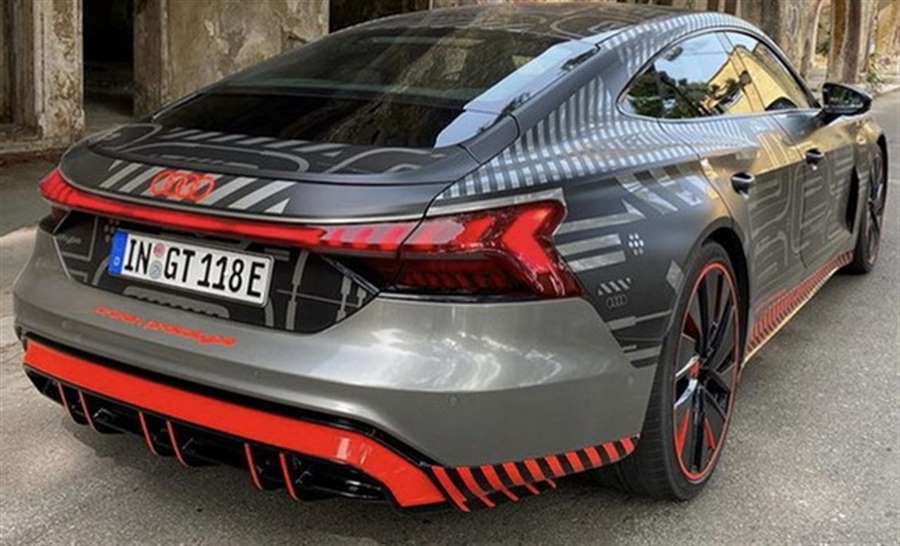
BMW also has ambitious plans when it comes to electrifying its models, although it seems that the latter has arrived "at the party". The BMW iX is the first true electric car from the Bavarian manufacturer since the i3, and it is not yet officially on sale. Although Audi’s e-tron models on the market rest on existing platforms, they are not just electrified versions of existing models, as is the case with the BMW iX3. The same can be said for the Mercedes-Benz EQC. Of course, Munich also plans to fill the electric offer in the near future, including the i4, the electrified series 7, the iX1 and possibly even the electric M5. BMW also wants to phase out internal combustion engines, although the deadline for achieving that process could be slightly longer than Audi's.
New Toyota RAV4 plug-in hybrid 2021 review
The ever-popular Toyota RAV4 SUV gets plug-in hybrid power for first time
From a technological point of view, the RAV4 Plug-in Hybrid is an impressive achievement. This is a comfortable and refined plug-in hybrid SUV – as long as you keep charging it from the plug instead of via the engine. There’s acres of space in the well stocked and well finished cabin, and the boot is still huge. The price tag is big, too, but the ultra-low Benefit-in-Kind taxation rates mean that Toyota could be on to a winner with company car buyers. The Suzuki Across – which is almost identical – is cheaper still, though.
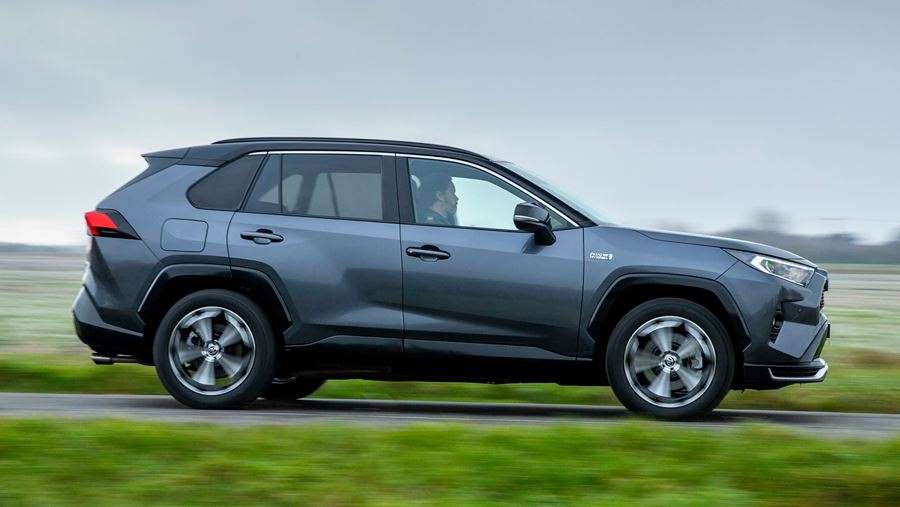
Toyota’s hybrid expertise takes a new turn in 2021 with the introduction of this: the RAV4 Plug-in Hybrid. It’s a bit of a missing link for this popular large SUV. Toyota made a fully electric RAV4 for its first two generations, but for the US market only, while the last version of the car to be replaced had a conventional hybrid powertrain to bring an electrified RAV4 to the masses.
Now, with CO2 targets ever harder to hit, Toyota sees plug-in hybrid power as a catch-all, delivering mass market appeal combined with ultra-low emissions and running costs.
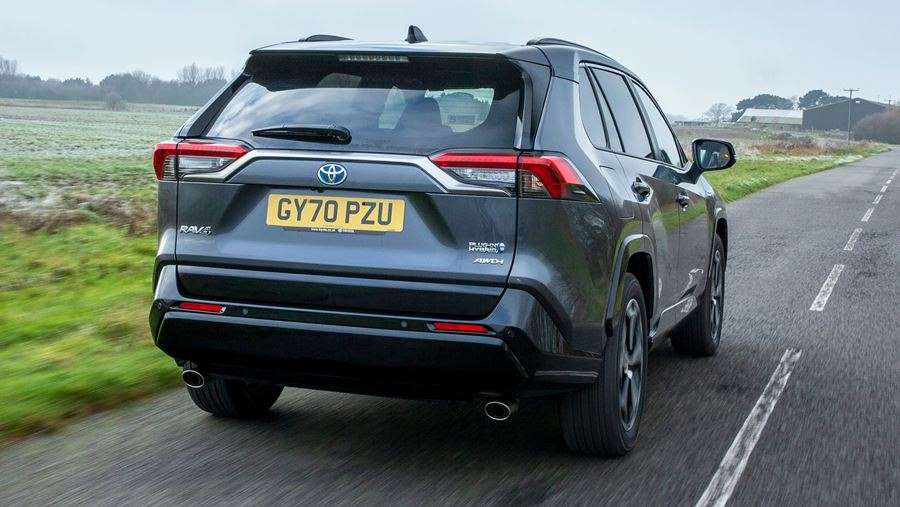
The new car has a 2.5-litre four-cylinder petrol engine developing 182bhp and linked to a CVT transmission, but the battery and dual-electric motor set-up take centre stage. A large 18.1kWh battery is located beneath the rear seats, while the front motor is rated at 134kW (176bhp) and the rear at 40kW (53bhp). The engine and electric motors don’t produce maximum output at the same time, so peak power is rated at 302bhp.
With two electrified axles, the RAV4 drives through its electric motors nearly all the time. The engine is there mainly for generating charge, and only occasionally sends drive directly to the front wheels. The driver can flick through four modes – EV for pure electric running, EV/HV, which shuffles between fully electric and hybrid power automatically, HV for solely hybrid running, and a charging mode, which sees the engine top up the battery on the move.
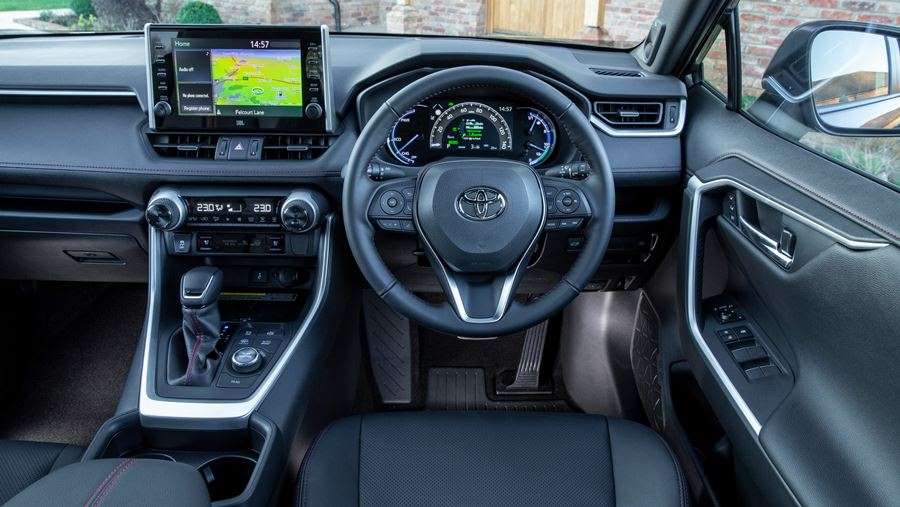
From start-up, the RAV4 defaults to EV mode if there is enough charge in the battery. Keep the cell topped up – it can be recharged in 7.5 hours from a household plug or as little as 2.5 hours from a 7kW wallbox – and there’s plenty of all-electric range to lean on.
EV mode really means just that, and little will provoke the engine into action. Toyota claims up to 46 miles of pure-electric running is possible, and we managed 35 silent miles with no real effort. The car is extremely smooth, and on electric power alone it’s certainly fast enough for day-to-day life. Its acceleration is comparable with that of the entry-level 2.0-litre petrol RAV4. The top speed on electric power is 84mph.
When the battery is drained, the RAV4 automatically switches into EV/HV mode, but you’ll still wonder if the engine is involved. The transition between the two power sources is seamless, and even having a CVT transmission doesn’t seem to be a problem. The engine drops in and out, contributing when it needs to and quietly leaving when not required. It’s a very impressive piece of engineering.
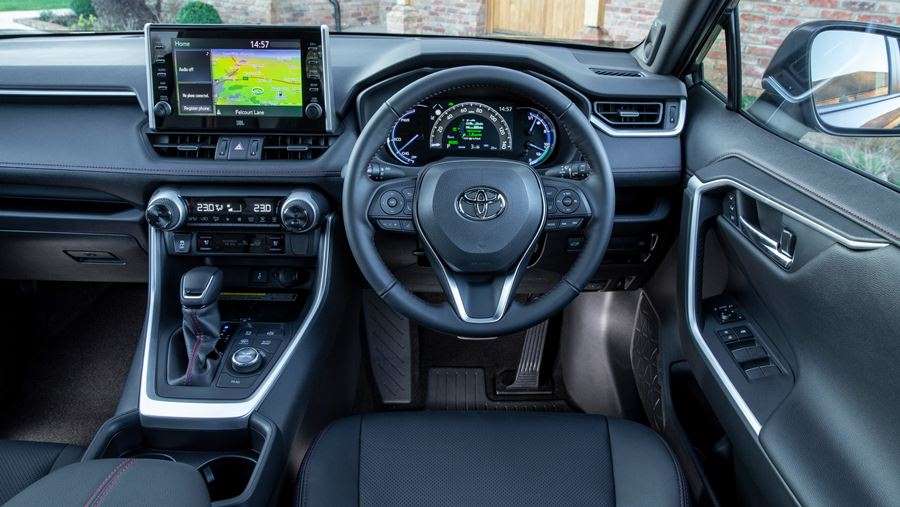
You’ll also discover Eco and Sport modes on top of the drivetrain options. They alter the state of performance, with Eco mode dulling throttle responses in the pursuit of efficiency, and Sport mode giving you maximum power in one hit.
Although 0-62mph takes just six seconds, the RAV4 is not a car you’ll want to hurry in. Instead it’s a solid cross-country cruiser, with good ride quality at speed. The weight and firm springing mean it’s slightly fussy at low speed around town, though, and not quite as comfortable as the other RAV4 variants. It’s got nice steering, great visibility and loads of space for adults front and rear. But Toyota’s newcomer is heavy and it feels it, so while 302bhp sounds like a recipe for fun, it’s best to sit back and enjoy the impressive levels of refinement.
The only flaw in this otherwise spookily smooth and silent package is exposed when you tap into the recharge mode. Asking the engine to constantly top up the battery introduces trademark CVT wailing. Up hills the revs are intrusive and coarse, but it’s a small trade-off to pay when you consider the rest of the package.
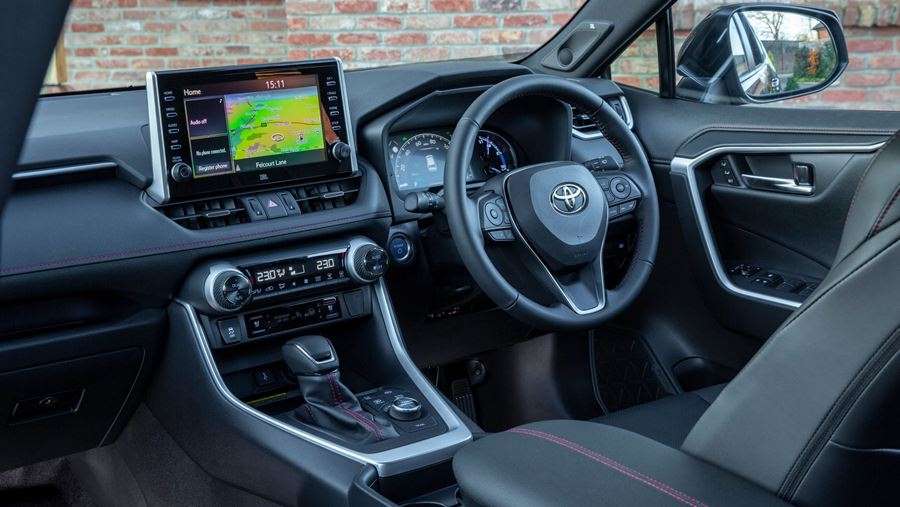
Toyota claims fuel economy of 282.5mpg. That’s a rather fanciful figure, but you can expect around 55-60mpg in the real world, or more if you do as you should, and plug in on a daily basis. CO2 emissions of just 22g/km mean company car users profit the most from the RAV4’s tiny Benefit-in-Kind tax rate of just seven per cent for the 21/22 tax year. Those in the 40 per cent bracket can expect a tax bill next year of around £1,424, so compared with standout rivals, the Toyota’s financials make strong sense.
The only problem nipping at its heels is the near-identical Suzuki Across PHEV, which, thanks to its slightly smaller price tag, has a slightly smaller tax bill, too – £1,275 for 21/22 for higher-rate taxpayers. However, we found the Suzuki wasn’t quite as comfortable on the road as the Toyota.
Prices for the RAV4 PHEV start from £47,395 in Dynamic trim, rising to £50,895 for this Dynamic Premium car. That’s quite a chunk, and compared with rivals such as the Peugeot 3008 HYBRID4, the RAV4 is a pricey option with its large battery.
But this trim does bring a panoramic roof, black leather upholstery, and heated and cooled electrically adjustable seats. Even heated rear seats are standard. It feels plush and very well made, if lacking a little sparkle in its design. The only real weak point is the nine-inch infotainment, with its cheap-feeling buttons and dated graphics. Yet standard Apple CarPlay and Android Auto allow you to bypass this using a smartphone.
Source: autoexpress.co.uk
Ford Escort Cosworth from the Wheeler Dealer series is for sale
Although it follows the history of a relatively "simple" car driven mostly by those who have not been able to afford anything better, the Escort model is actually a great Ford legend. It has been produced for more than three decades around the world and in that period it found over 20 million customers, and today it can be found in sales in China. As we mentioned, the Escort didn’t often bring some technical revolution, but it certainly had plenty of high-performance versions.
Perhaps the most famous of them is the one tuned by the famous British house Cosworth, and produced from 1992 to 1996.
In that period, only 7,145 copies were sold, which was enough for the Escort homologies for the World Rally Championship (VRC). The detail that attracts the most attention is certainly the mechanics, so Cosworth developed a special 2.0-liter engine with 224 horsepower, which allowed acceleration from standstill to 100 km / h in just 5.7 seconds, with a top speed of 237 km / h. h.

Power is normally transmitted to all four wheels via a five-speed manual transmission. An interesting detail is that Ford actually developed this car around the chassis and mechanics of the larger Sierra model, and then somehow "stuck" the Escort shell on it, which acts as a smaller, compact four-wheeler.
Now that we know all this, we will mention that there is an extremely rare Cosworth in the ad, and for several reasons. First of all, when it was new, this athlete is sold only in Europe, but since certain specimens are now older than 25, its import is also allowed in America.
The copy from our story is one of only 25 units that Sun International introduced "across the pond", and only twelve of them are currently registered. Then it fell into the hands of the leading popular series Wheeler Dealer, Mike Brewer in the first episodes of fourteen seasons, at a price of 30,000 US dollars. Mechanic Ent Ensted released another 7,665 smallest greenbacks and spent them to refresh the turbo and replace the clutch, brakes and a few visual details, and Frank Stevenson also called for help.
This legendary designer was actually responsible for the design detail that made the Cosworth brand famous, and of course it is the last connector. He modified and processed modern technology to provide even greater stability in corners, and the car was then sold to the original owner for 50 thousand US dollars.
We will mention that Stevenson, in addition to Escort, also worked in the team that designed the BMW X5, Mini Cooper, Maserati MC12, Ferrari F430, McLaren MP4-12C and 720S.
The car is still in America and the federal state of Washington, and it is sold by the company Northwestern Europe, which mainly deals with rare four-wheelers from the continent of Stari. The watch has a figure of 51,000 miles (82,077 kilometers), and the modifications made by Wheeler Dealer were supposed to raise the power to about 280 "heads". This particular model also provides Recaro sunroof and leather seats.
Northwest Europe did not want to announce the price, but believes that the potential buyer should send their offer, and then it will be said to be acceptable.

